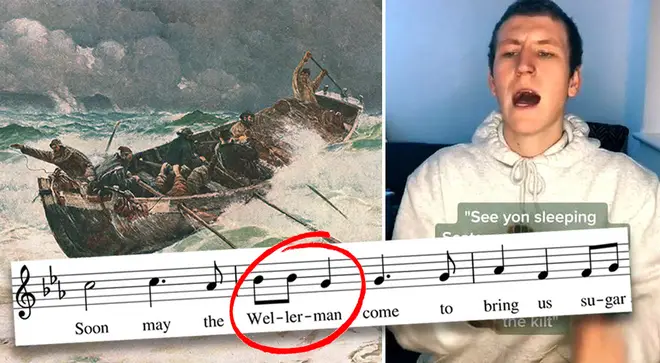On Air Now
Classic FM Breakfast with Dan Walker 6:30am - 9am
22 January 2021, 17:58 | Updated: 15 February 2022, 10:29

TikTok has gone overboard in its thirst for them, and the Internet can’t stop slapping its collective thigh to their steady, reassuring rhythms. But musically speaking, what actually are sea shanties – and what’s their history?
In case you’ve been living under a rock, social media has been awash the last few weeks with collective renditions of these earwormy, profoundly reassuring songs called sea shanties.
Melodies like ‘The Wellerman’ and ‘(What Shall We Do with the) Drunken Sailor’ have been popping up in videos everywhere. And the trend all began with a postman named Nathan Evans, who started singing the folk songs in his bedroom in Scotland and posting them to TikTok, unaware his videos would lead to a full-blown shanty renaissance.
Musicians all over the world have been jumping on board and adding their own parts to Evans’ vocals – from folksy violinists, gravelly baritones and descant-loving sopranos, to actual Andrew Lloyd Webber, who turned Evans’ hummable rendition of ‘The Wellerman’ into a duet with a little tickling of the Yamaha ivories.
“This is absolutely incredible and just… wow. I’m speechless,” Evans replied to the Cats composer’s virtual edit. “Brilliant – well done!” ALW graciously replied on the platform.
And the Shanty King’s success story shows no sign of waning, as this week he secured a contract with Polydor Records, the Universal record label whose impressive list of artists includes Billie Eilish and Gary Barlow. Knot too shabby.
Read more: Why TikTok is singing sea shanties to its heart’s content >
But what actually are sea shanties, what’s their history and – with music theory hats firmly on – why did sailors sing them?
Andrew Lloyd Webber joins Shanty TikTok pic.twitter.com/DdeYbQ4C3C
— Fiona. (@fiona_day) January 18, 2021
Sea shanties are a type of collective folk song, typically performed on ships by fishermen, merchant sailors or whalers.
They were sung not to celebrate a return home, or to chant down the pub, but to accompany the heavy, repetitive tasks of sail-hoisting and deck-scrubbing.
Shanties were ‘work songs’, in essence, whose steady beat helped unite a shipload of sailors in one rhythm, making lighter work of arduous chores.
They also likely helped provide a musical tonic, and a distraction from the repetitive nature of the work. Much as you might pop a Brahms symphony on when you’re cleaning the bathroom.
Read more: Why TikTok is singing sea chanties to its heart’s content >

The Wellerman - TikTok Sea Shanty mashup 2021
Sea shanties go back a long way – but no one can quite agree on how long.
Popular thought says shanties show an African influence, their form being inspired by the rhythms and call-and-response of African work songs. This musical form, also known as antiphony, is believed to have made its way onto 19th-century merchant ships, where distinctly Anglo-Irish lyrics were added and the songs were used to coordinate sailors’ labour.
It’s thought that their name, ‘shanties’, came through French influence, the French word for ‘singing’ being ‘chanter’.
In these work songs, one sailor would take the role of ‘calling’ a line, for the collective group to ‘respond’ across the deck.
Different types of shanty existed for different kinds of work, with musical accents carefully placed to coordinate merchants on specific tasks, like sail-hoisting. Tempo was important, too, with the need to synchronise on speed for certain chores.

Drunken Sailor - TikTok Sea Shanty Epic Mashup 2021
Sea shanties range from easy to more complicated arrangements, but most have melodies and lyrics that would have been easy to pick up, and simple enough for merchant sailors to remember.
Most shanties come in 4/4 time, an easy beat to keep track of, or sometimes the more typically Irish-Scottish folk song time of 6/8, which lends itself well to storytelling and seems to mirror the up-and-down movement of waves.
They also were typically sung a cappella – without instrumental accompaniment – and often contained punchy moments of collective sound like ‘Haul!’ or ‘Ho!’ to help coordinate and create energy during heavy-duty chores.
Away from the theory side of things, sea shanties – much like gospel songs, thinking to the ever-joyous ‘O Happy Day’ – help us feel like we’re part of something bigger, a collective musical moment that perhaps sailors found comfort in, being away at sea and from their loved ones for long periods.
Certainly, looking to the 2021 shanty revival, that shared singing experience is something many of us are yearning for and finding, rather beautifully, in the heart of the TikTok community.